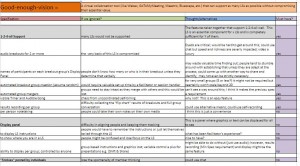I was bummed to miss the September Liberating Structures Seattle User Group meeting as it was about using LS online. (If you don’t know what LS is, click that first link!)
I am passionately interested in this. Today, I had a chance to see the notes and a “minimum specs” document in the works and was VERY HAPPY. (I uploaded it to GoogleDrive so we can all play with it together! I hope that is OK with Keith McCandless, Jim Best, Alex Dunne and Fisher Qua. Guys, ok?
I first want to share the notes. I’m adding my comments in bold.
User Group members got a good start on Min Specs for bringing virtual meetings back to life.
1. Distributing information must not be the purpose of convening a virtual meeting. Firmly invite participants read the material in advance–no ifs, ands, or buts. Stop the madness of long-boring-stifling-ineffective PPT presentations. AMEN. True online and offline, but I think even more toxic online. People multitask themselves into oblivion. This is also one of the challenging points to convey to “meeting” sponsors. So thinking more about how to engage positively and proactively on this set up issue is on my mind.
2. Asking questions that invite participants to explore a shared challenge must be part of the virtual meeting purpose. For example, if the topic is “what can we do about poor employee engagement scores?,” a set of productive questions could include: How do you know when people are not engaged? What do you do to maintain your own focus? How do you help others do the same? What makes it difficult to maintain a positive and engaged attitude? Do you know anyone or any group who is able to maintain high engagement consistently or effortlessly? How?? Are any good ideas coming to mind? Any 15% Solutions? What first steps could we take together? [Adapted from Discovery and Action Dialogue] This set of questions sparks both self-discovery and action to move forward together. Ahhhhh. For me this is true online and offline. So the online elements are how people respond (voice, text, group size — i.e. 1-2.4-all) and what type of design and facilitation enables coherence if we cross different communication forms. Some people type. Some need to talk, etc.
3. Contributing ideas must be very simple and safe for every participant. More coming… This builds on my last note from an operational perspective. I also think that sometimes the anonymity or semi-anonymity of the online space can actually make it “safer” than F2F.
via Liberating Structures – User Group Startup.
I keep waffling between the approach – find and adapt a tool and grow from there the practices, or use whatever is at hand and adapt the practices. The practical me says the latter. What do you think? (See more of our collective thinking here and here.)
P.S. I know, it has been a LONG time since I blogged. Longest gap ever. And this is a fast post, but I figured better fast than never!

I’ve been exploring pattern languages for conversations, for activism, for collaborations, and for online meetings, and I’m finally coming to the sense that the Group Works pattern set pretty well covers all these types of ‘group processes’. When it comes to online meetings, my approach now is to look at the nine pattern categories (intention, context, relationship, flow, creativity, perspective, modelling, inquiry & synthesis, faith/emergence) manifest differently in virtual environments, rather than looking for different patterns just because of the medium of the meeting.
My sense is that it is generally harder to invoke or draw upon a lot of the patterns in online events because such events lack some of the nuance and flexibility of face-to-face events; in a few cases online events allow some patterns (e.g. Whole Group and Subgroup) to be more easily invoked in online events, if the tool is good. The biggest challenge is that the ‘tools’ of face-to-face meetings (post-its, flipcharts etc.) are usually intuitive, while those for online meetings are rarely so and involve a learning curve.
Beyond that, as you say, I think most of what we consider patterns of exemplary facilitation (and participation) are applicable to some extent for both online and offline meetings.